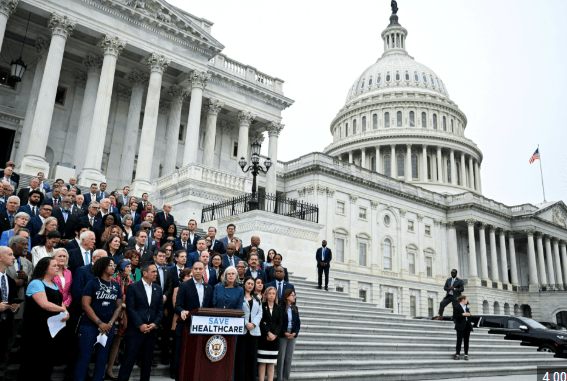WASHINGTON, D.C. — The federal government entered its first full day of shutdown Wednesday, and Russell Vought, Director of the Office of Management and Budget (OMB) under President Donald Trump, has issued a stark warning: federal employee layoffs could begin within “one to two days.”
The revelation came during a private conference call with House Republicans, where Vought confirmed that mass firings are imminent unless Congress passes a new spending bill to reopen the government.
“We will begin implementing workforce reductions if the shutdown continues,” Vought told lawmakers, according to GOP sources on the call.
Firings Could Replace Traditional Furloughs
In a memo released last week, Vought directed federal agencies to prepare Reduction in Force (RIF) notices — essentially permanent layoffs — for employees working in programs without current funding and deemed “not consistent with the President’s priorities.”
Traditionally, shutdowns have led to furloughs — temporary unpaid leave — not terminations. But this move signals a major policy shift that could redefine how future shutdowns affect federal workers.
No specific number of layoffs was announced, but union leaders and policy experts warn that hundreds of thousands of employees could be at risk if the shutdown drags on.
WIC Program Funding Running Dry
One of the first programs expected to feel the impact is the Women, Infants, and Children (WIC) nutrition program. According to Vought, funding could run out within a week, potentially affecting millions of families nationwide.
The National WIC Association confirmed that without congressional action, benefits could dry up in “one to two weeks,” forcing states to suspend support for low-income mothers and children.
Military and Federal Paychecks on Hold
Vought also cautioned that military service members, along with most federal employees, will not receive paychecks during the shutdown. This includes civilian defense staff, national park rangers, and agency personnel across departments.
National parks will remain partially open, though many visitor services will be scaled back due to limited staffing.
Political Showdown in Congress
The Senate failed — for the second time in 24 hours — to pass competing Democratic and Republican spending bills. Both proposals fell short of the 60 votes needed to advance, leaving no clear path forward.
Funding expired at 12:01 a.m. Wednesday, after lawmakers failed to reach a deal before the end of the fiscal year on September 30. Without a stopgap measure, most discretionary federal programs are now unfunded.
Vought blamed Democrats for the stalemate, saying the layoffs “would not be necessary if the opposition party had agreed to the President’s priorities.”
Legal Challenges Mount
Labor unions, including the American Federation of Government Employees (AFGE) and AFSCME, have filed lawsuits arguing that mass firings during a shutdown violate federal labor law and the Antideficiency Act.
Legal experts predict that courts could issue temporary injunctions to halt some of the planned layoffs. Still, the uncertainty is creating widespread anxiety across the federal workforce.
Economic Impact Could Be Severe
The Congressional Budget Office warns that an extended shutdown could cost billions in lost productivity and disrupt essential programs such as food assistance, housing aid, and veterans’ benefits.
The last major shutdown, in 2018-2019, lasted 35 days, making it the longest in U.S. history. Economists say a similar or longer closure could slow GDP growth and rattle financial markets.
What You Need to Know
Who’s affected: Non-essential federal employees, military personnel, contractors, and families relying on federal programs like WIC.
When layoffs may start: Within 48 hours, per Vought’s remarks.
Which programs are at risk: WIC, national parks, research grants, education funding, and more.
What’s next: Lawmakers continue negotiations, but no deal is in sight.
The Bigger Picture
The Trump administration’s approach reflects a broader effort to shrink the federal workforce and realign spending with “America First” priorities. Critics warn this strategy weaponizes shutdowns as a political tool, while supporters argue it’s a necessary step toward fiscal discipline.
As agencies brace for layoffs and families prepare for missed paychecks, the nation faces another test of how long Washington’s gridlock can last — and how far the administration is willing to go to enforce its budget vision.
Key Takeaways
Trump Budget Chief Russell Vought warns federal employee firings could begin within 1–2 days amid the 2025 government shutdown.
Reduction in Force (RIF) notices ordered for employees in programs no longer funded or not aligned with Trump administration priorities.
WIC nutrition program could run out of funding within a week, affecting millions of families nationwide.
Military and federal employee pay will be delayed as the shutdown halts regular operations.
Senate deadlock blocks new funding bills, prolonging the crisis with no bipartisan deal in sight.
Labor unions are filing legal challenges, calling the planned firings unlawful and politically motivated.
Shutdown could lead to mass layoffs, service disruptions, and a significant economic impact across the U.S.

